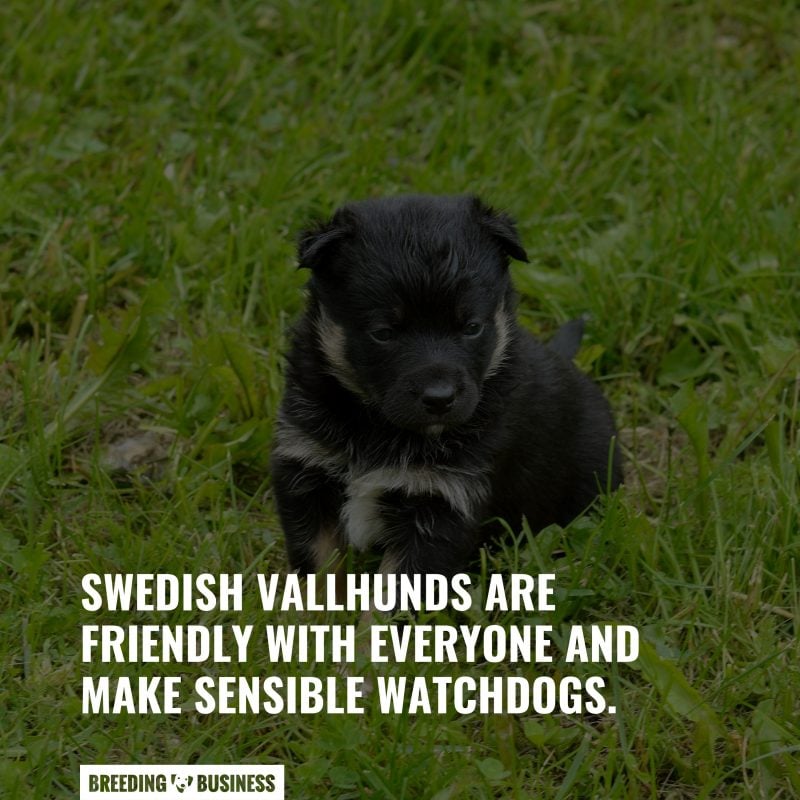Swedish Vallhunds are a cute, fun-loving breed with an interesting history. Keep reading to find out how to breed Swedish Vallhund dogs, as well as everything you need to know about them!
Whether you’re interested in breeding Swedish Vallhunds or just becoming an owner, use our breed profile to learn all about them and how to meet their needs.
Background of Swedish Vallhund Dog Breeding
Let’s take a quick look at the history of this breed.
Origins
The Swedish Vallhund is an ancient dog breed of Swedish origin, specifically the county of Västergötland, that dates back to the 8th or 9th century. They were originally used to guard and herd cows on Swedish farmland.
Vallhunds are said to be descended from much larger, even older breeds, such as the arctic sled-pulling Spitz dogs and the moose hunting dogs of Scandinavia. They are also thought to have been part of the Viking settlement in Great Britain, which lead to the development of the modern Welsh Corgi. Their closest relatives are other Nordic Spitz breeds such as the Norwegian Elkhound. In fact, the skeletons of Elkhounds and Vallhunds are almost identical.
The Modern Swedish Vallhund
The breed came close to extinction in 1942 due to the financial impact of World War II. However, efforts were made to save the breed after they were recognized by the Swedish Kennel Club in the following year.
Nowadays, they are no longer used as working dogs, but often compete in dog sports due to their athletic ability and herding skills, as well as being beloved family pets.
The first litter of Swedish Vallhunds was born in the US in the 1980s, and although they are not a popular breed in the US, (ranking 169 out of 197 breeds according to the AKC), they are well-loved by their owners and remain popular in their home country of Sweden.
Appearance
The Vallhund’s appearance is wolf-like, with a wedge-shaped head, a long snout, dark brown oval-shaped eyes, and pricked triangular ears. They have long bodies, short legs, and variable tail lengths, from no tail at all to full length and plumed.
Size and Weight
The average height and weight of a male Swedish Vallhund are approximately 12.9 inches and 12-14 kg, with the average female standing at 12.2 inches and weighing 9-11 kg.
Coat
Swedish Vallhunds have double coats consisting of a soft, dense undercoat, and a short-medium length, a coarser topcoat that has softer, fluffier patches on the chest and stomach.
Their coats are Sable patterned and most commonly shades of grey, such as yellow-grey, grey, and brown-grey, but can also include reddish-brown.
Markings include darker hair on the back, neck, and sides of the body. Lighter cream-colored hair may cover the muzzle, neck, chest, stomach, hind, legs, feet, and on the tip of the tail. They also typically have lighter markings across their shoulders, commonly known as harness markings.
Personality
Swedish Vallhunds are energetic, playful, and very intelligent dogs due to their working DNA. They require lots of physical exercise and mental stimulation to curb boredom which can result in destructive behaviors.
Vallhunds are fiercely loyal and loving towards their families and friendly towards strangers. They love to be involved in family life wherever possible and love to be around children.
Whilst they are courageous watchdogs, they are not aggressive and will get on with other dogs and pets with plenty of socialization.

Training
Owners should spend time building a bond before attempting training, and start training as early as possible. Vallhunds are highly intelligent and trainable dogs, but with high energy and intelligence comes stubbornness and a low tolerance for boredom. To avoid boredom and stubborn behavior, training sessions should be kept clear, concise, consistent, and fun.
Positive reinforcement should always be the dominant force. The use of a behavioral marker, such as a clicker, before a reward, will speed up the learning process. Negative signals like the word “no” should be used consistently with a non-physical negative association to be effective.
Areas that Swedish Vallhund owners may need to particularly focus on include nipping and excessive barking. A little growling and barking during social interaction and play are normal. However, if it becomes excessive, you can teach your dog to stop by stopping your interaction when the behaviors start. This teaches them that the fun stops when the barking or nipping starts.
Swedish Vallhund Care
Vallhund puppies need 5 minutes of exercise per month of their age per day. A fully grown Vallhund need at least 45 minutes of physical exercise every day, preferably split into two walks. These dogs often stay active into old age, but their daily exercise routine should become gradually less demanding as they age.
Owners should engage in fun, challenging games such as hide and seek with their Vallhunds on a regular basis to avoid boredom. They also benefit from having some mentally stimulating toys like puzzles and treat dispensers.
A Swedish Vallhund should eat ¾ a cup to 1 ¼ cups of food per day, ideally split into two meals, depending on their age, size, and activity level. Their diet should consist of a high-quality kibble that gives complete nutrition, and natural sources of protein like chicken and fish. Valls should also eat nutritious, fiber-rich fruits and vegetables to support good digestion and overall health. The breed is prone to obesity, so avoid low-quality commercial dog foods that contain filler ingredients like grains.
Their coats need brushing once a week with a firm brush to remove loose fur and debris. During shedding seasons, a de-shedding tool may come in handy. The breed doesn’t need haircuts or regular baths but should be cleaned whenever they are dirty.
Common Health Issues for Swedish Vallhund Dogs
Swedish Vallhunds have an average lifespan of 12-14 years. They are generally healthy dogs, but all breeds are susceptible to certain conditions. These are the conditions that most commonly affect the breed.
The American Kennel Club suggests all Vallhund pups receive an SV Retinopathy DNA Test, a hip evaluation, and an ophthalmologist evaluation.
Retinopathy
Retinopathy is a hereditary condition that causes the deterioration of the retina; the part of the eye that is responsible for vision in low light, detecting color and tracking movement. It leads to partial or complete blindness, how quickly is case-specific and depends on the severity of the condition. Dogs can show signs when they are young or older. The type of retinopathy that affects Swedish Vallhunds is specific to the breed. Dogs with symptoms should be taken to see a vet for an eye examination.
There is, unfortunately, no cure for retinography, but thankfully, it is not a painful condition. However, it can be very frightening and owners should invest in some anti-anxiety products if their dogs are showing signs of stress. That said, blind dogs can live long and happy lives. Extra care should be taken at home with furniture and trip hazards. New indoor and outdoor locations should be walked around on a lead first so that your dog can map it out in their mind.
The symptoms of retinopathy include:
- Vision loss, starting with night blindness and anxiety around dark places or nighttime
- Increased clumsiness
- Dilated eyes that are reflective of light
- No eye contact during interaction (advanced stages/severe cases)
- Stress
Patellar Luxation
A luxating patella is a condition that causes the kneecap (patella), to dislocate. It’s quite common in smaller breeds like Vallhunds and can be diagnosed with a simple veterinary exam. Causes can be genetic or traumatic, but the condition can only be corrected with surgery.
That said, correction is only necessary if it is causing pain and most dogs don’t experience any pain with the condition. A mildly dislocated patella can be managed with lifestyle changes and physiotherapy.
The symptoms of a luxating patella in dogs include:
- Lameness
- Stiffness
- Whining and licking the affected knee
Dysplasia
Hip dysplasia and elbow dysplasia are congenital conditions that cause the hip or elbow joints to form abnormally. They become loose and shaky over time and it eventually leads to arthritis. There is no cure but it can be managed. An early diagnosis can also delay the condition from getting worse.
Mild dysplasia requires lifestyle changes and non-surgical therapies, whilst severe dysplasia will need surgery to fix the joint. Either way, dogs with dysplasia should go on to lead long and happy lives.
The symptoms of dysplasia include:
- Limping or bunny hopping
- Difficulty with activities such as jumping and climbing
- Whining and licking the affected joints
- Loss of muscle mass
- Exercise intolerance
- Low mood, sometimes irritability
- Inability to get comfortable
Breeding Swedish Vallhunds
If you are a first-time breeder, make sure you have the appropriate breeding licenses and that your dogs are free from any genetic health conditions.
Litter & Puppyhood
Swedish Vallhunds tend to be born into litters of 6-8 puppies. They should weigh around one pound at birth and usually grow to their full, adult size between 6-8 months old. Pups should live on their mothers’ milk for the first 4-8 weeks of their lives and should be gradually eased onto kibble and milk replacer, and eventually dry kibble by 8 weeks old.

Common Birthing Problems
Pregnancy can be difficult for Vallhund mothers because of the pressure it puts on their narrow bodies. Dystocia or difficult birth is common, and many mothers end up undergoing cesarean sections. Breeders should familiarise themselves with the signs of dystocia in dogs and know where the nearest emergency vet hospital is just in case.
Cost
The average cost of a Swedish Vallhund puppy is currently between $500-$1500 in the US, although it can be more. The exact cost will depend on the breeder. Puppies from large, commercial breeders will usually be cheaper than one from a small-time or hobby breeder. However, the higher cost usually means that there is a much better quality of care.
The pup’s coat color and lineage can also affect the price. Those bred from show dogs or competitors in dog sports will have a much higher price tag. Dogs with rarer coat colors will also be more expensive. Rescue Vallhunds will cost the shelter’s adoption fee – which could be anywhere from fifty to a few hundred dollars, depending on the size of the shelter and whether they are generic or breed-specific.
The average annual cost of looking after an adult Vallhund is approximately $1135 per year. This is split into around $460 for health care and insurance, $145 for food and treats, and $215 for toys and accessories. This will likely be more expensive in their first year, as teething pups tend to go through more supplies and new owners will have to pay for those initial vet visits. Similarly, elderly dogs tend to cost more because they have higher medical costs.
Swedish Vallhund Breed: FAQ
Swedish Vallhunds are average shedders and therefore not classed as a hypoallergenic breed.
Vallhunds are great family dogs and love family life. They also get on well with children and other family pets with plenty of early socialization. Children should always be taught how to interact kindly and safely with dogs.
Vallhunds are naturally vocal dogs because of their working DNA. It’s just their way of expressing themselves. However, if barking becomes excessive, you can teach your dog to stop by stopping your interaction when the behavior starts. This teaches them that the fun stops when the barking starts.
Swedish Vallhunds are cute, loyal, playful dogs with an interesting history. Always breed ethically and responsibly and always buy from highly-rated breeders, or adopt from a shelter.
